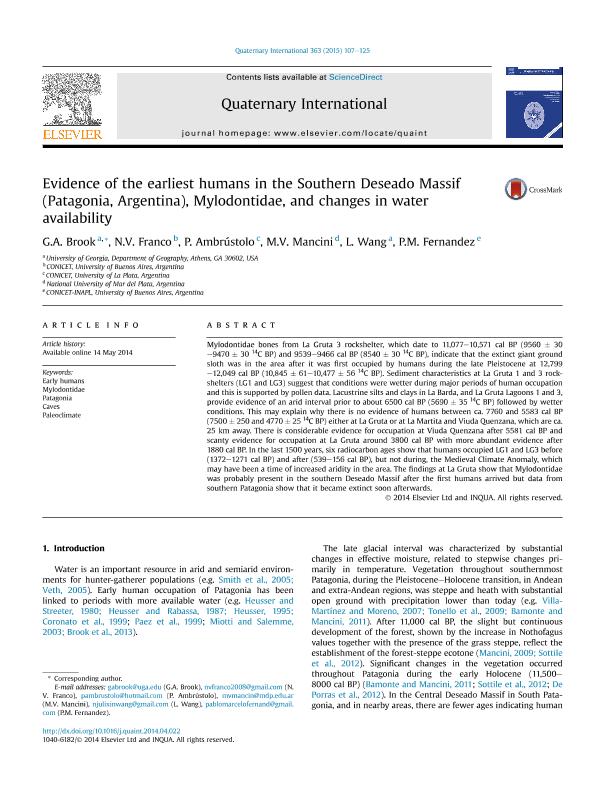Mostrar el registro sencillo del ítem
dc.contributor.author
Brook, G. A.
dc.contributor.author
Franco, Nora Viviana

dc.contributor.author
Ambrustolo, Pablo

dc.contributor.author
Mancini, Maria Virginia

dc.contributor.author
Wang, L.
dc.contributor.author
Fernández, Pablo Marcelo

dc.date.available
2018-06-26T15:48:39Z
dc.date.issued
2015-03
dc.identifier.citation
Brook, G. A.; Franco, Nora Viviana; Ambrustolo, Pablo; Mancini, Maria Virginia; Wang, L.; et al.; Evidence of the earliest humans in the Southern Deseado Massif (Patagonia, Argentina), Mylodontidae, and changes in water availability; Pergamon-Elsevier Science Ltd; Quaternary International; 363; 3-2015; 107-125
dc.identifier.issn
1040-6182
dc.identifier.uri
http://hdl.handle.net/11336/50075
dc.description.abstract
Mylodontidae bones from La Gruta 3 rockshelter, which date to 11,077-10,571calBP (9560 ± 30-9470 ± 3014CBP) and 9539-9466calBP (8540 ± 3014CBP), indicate that the extinct giant ground sloth was in the area after it was first occupied by humans during the late Pleistocene at 12,799-12,049calBP (10,845 ± 61-10,477 ± 5614CBP). Sediment characteristics at La Gruta 1 and 3 rockshelters (LG1 and LG3) suggest that conditions were wetter during major periods of human occupation and this is supported by pollen data. Lacustrine silts and clays in La Barda, and La Gruta Lagoons 1 and 3, provide evidence of an arid interval prior to about 6500calBP (5690 ± 3514CBP) followed by wetter conditions. This may explain why there is no evidence of humans between ca. 7760 and 5583calBP (7500 ± 250 and 4770 ± 2514CBP) either at La Gruta or at La Martita and Viuda Quenzana, which are ca. 25km away. There is considerable evidence for occupation at Viuda Quenzana after 5581calBP and scanty evidence for occupation at La Gruta around 3800calBP with more abundant evidence after 1880calBP. In the last 1500 years, six radiocarbon ages show that humans occupied LG1 and LG3 before (1372-1271calBP) and after (539-156calBP), but not during, the Medieval Climate Anomaly, which may have been a time of increased aridity in the area. The findings at La Gruta show that Mylodontidae was probably present in the southern Deseado Massif after the first humans arrived but data from southern Patagonia show that it became extinct soon afterwards.
dc.format
application/pdf
dc.language.iso
eng
dc.publisher
Pergamon-Elsevier Science Ltd

dc.rights
info:eu-repo/semantics/openAccess
dc.rights.uri
https://creativecommons.org/licenses/by-nc-nd/2.5/ar/
dc.subject
Caves
dc.subject
Early Humans
dc.subject
Mylodontidae
dc.subject
Paleoclimate
dc.subject
Patagonia
dc.subject.classification
Historia

dc.subject.classification
Historia y Arqueología

dc.subject.classification
HUMANIDADES

dc.title
Evidence of the earliest humans in the Southern Deseado Massif (Patagonia, Argentina), Mylodontidae, and changes in water availability
dc.type
info:eu-repo/semantics/article
dc.type
info:ar-repo/semantics/artículo
dc.type
info:eu-repo/semantics/publishedVersion
dc.date.updated
2018-06-26T13:55:19Z
dc.journal.volume
363
dc.journal.pagination
107-125
dc.journal.pais
Estados Unidos

dc.description.fil
Fil: Brook, G. A.. University of Georgia; Estados Unidos
dc.description.fil
Fil: Franco, Nora Viviana. Universidad de Buenos Aires; Argentina. Consejo Nacional de Investigaciones Científicas y Técnicas; Argentina
dc.description.fil
Fil: Ambrustolo, Pablo. Universidad Nacional de La Plata; Argentina. Consejo Nacional de Investigaciones Científicas y Técnicas; Argentina
dc.description.fil
Fil: Mancini, Maria Virginia. Universidad Nacional de Mar del Plata; Argentina
dc.description.fil
Fil: Wang, L.. University of Georgia; Estados Unidos
dc.description.fil
Fil: Fernández, Pablo Marcelo. Secretaría de Cultura de la Nación. Dirección Nacional de Cultura y Museos. Instituto Nacional de Antropología y Pensamiento Latinoamericano; Argentina. Consejo Nacional de Investigaciones Científicas y Técnicas; Argentina
dc.journal.title
Quaternary International

dc.relation.alternativeid
info:eu-repo/semantics/altIdentifier/doi/http://dx.doi.org/10.1016/j.quaint.2014.04.022
dc.relation.alternativeid
info:eu-repo/semantics/altIdentifier/url/https://www.sciencedirect.com/science/article/pii/S1040618214002304
Archivos asociados
